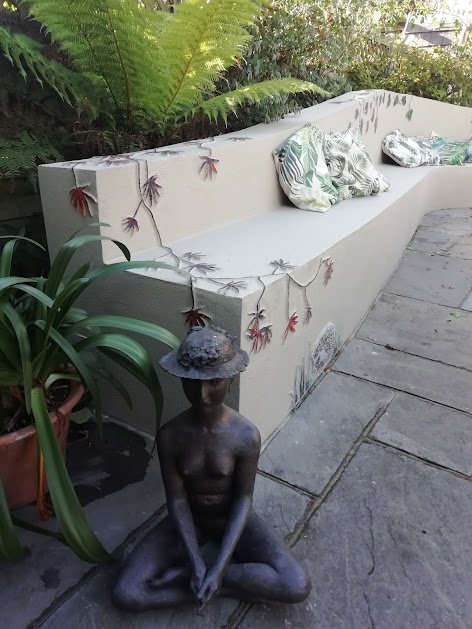Helen’s Bench
This was a commission for a private client who had a 7 m long concrete bench in her garden. She was not happy with the sharp angles and hard lines on the bench, which was not blending harmoniously with the garden design and furniture.
The original bench
We looked at different solutions and opted for a delicate and elegant combination of leaves and branches which would give movement and suppleness to the whole, as well as hide the corners and sharp angles, without excessive coverage. The mosaic foliage needed to blend in with the surrounding garden plants and be suitable for all seasons. No pink flowers, no light greens and yellows, nothing massive.
We decided on a palette of colours which would combine well with the rest of the garden.
I then created a paper mâché model of the bench to a scale of 1/10, and painted it with the same paint as the actual bench so that we could try different layouts and designs.
We chose to use ivy leaves because they are perennial, acer leaves for their beautiful autumnal colours, and passiflora leaves for their vibrant greens and white and purple flowers.
We considered adding animals, but the design had to remain stylish and discreet, so we thought a little hedgehog hiding at the bottom would add a fun touch.
I then started the work on the leaves, off site.
Before going to site, I decided to grout and cement the leaves so that they would be ready to stick to the bench as quickly as possible. For this, I covered the back of the leaves (visible in the photos - indirect method of mosaic) with mesh and tile adhesive, and once set, removed the kraft paper with water and a sponge, and grouted. The leaves were then rigid enough to be transported safely to site.
I made various samples with grey, white and black grout. The most beautiful in the end was our good old grey grout.
A layer of mesh to reinforce the fragile leaves and stems.
We then worked on the precise positioning of the leaves and their stems, using string and adhesive tape. The stems would need to be mosaicked directly onto the bench during installation. Once the position was firmly agreed, I had to strip the paint from the bench where the leaves and stems would go, otherwise the tile adhesive would not stick for long. Stripping paint off a concrete bench turned out to be the most time-consuming part of the installation. Paint stripping is hard work in a heat wave!
We were ready for installation. This happened, luckily, during a very dry week, and unluckily, during a very hot week too, which meant that the cement was drying extremely fast and I had to work as fast as possible myself.
Cats not allowed on paint stripper! This one had a narrow escape...
irty work... Grouting once the leaves and stems had been cemented .
Starting to look good!
The passiflora flower. Very beautiful, but one is enough, says the tense mosaicist after spending hours on the grinder creating the stamens and pistil.
We still had one thing to do: the hedgehog. As with the leaves, he was done using a reverse method on kraft paper, the pieces being glued with an adhesive made of flour and water, which I find easier to manipulate and work with than PVA glue.
This little animal looked very cute and life-like, and was installed where we had originally planned. However, it was a bit lonely down there, so a few acer leaves went further down from their branch to direct the gaze towards the hedgehog, and we gave him a few grass leaves for company.
All that was now needed was a lick of paint on the entire bench to give it its original fraicheur, et voila!



















